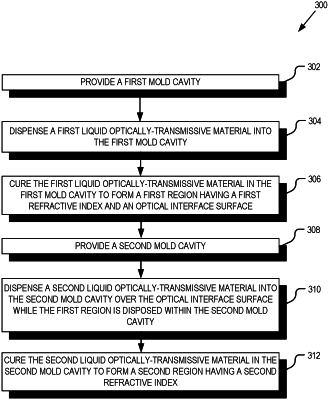| CPC B29D 11/00403 (2013.01) [B29C 35/0805 (2013.01); B29D 11/00442 (2013.01); G02B 13/006 (2013.01); G02B 27/0172 (2013.01); B29C 2035/0827 (2013.01)] | 14 Claims |

|
1. A method of fabricating a lens, the method comprising:
providing a first mold cavity;
dispensing a first liquid optically-transmissive material into the first mold cavity;
curing the first liquid optically-transmissive material in the first mold cavity to form a first region of the lens having a first refractive index, wherein the first region includes an optical interface surface;
providing a second mold cavity;
dispensing a second liquid optically-transmissive material into the second mold cavity over the optical interface surface while the first region of the lens is disposed within the second mold cavity; and
curing the second liquid optically-transmissive material in the second mold cavity to form a second region of the lens having a second refractive index, wherein an optical interface between the first region and the second region conforms to the optical interface surface, wherein providing the first mold cavity comprises mating a first die with a second die to define the first mold cavity, and wherein providing the second mold cavity includes:
removing the second die to expose the optical interface surface of the first region; and
mating a third die with the first die to define the second mold cavity.
|